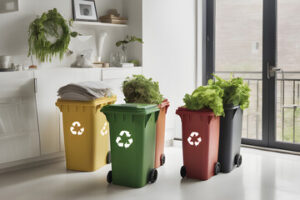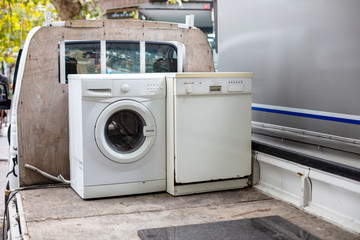Make a Positive Impact With Green Waste Collection
Green Waste Collection Mandurah is a way for residents to impact our environment positively. When food and yard waste is thrown away, it decomposes in landfills and releases methane, an important greenhouse gas contributing to global warming.
This organic waste is collected to a composting or anaerobic digestion facility for processing. This produces a nutrient-rich soil that can be used for landscaping or in parks.

A day of mowing the lawn and trimming trees can leave you with a pile of leaves, branches and sticks. Whether you’re landscaping a residential property or overseeing a commercial construction project, it’s important to dispose of yard waste correctly. It’s not only better for the environment, but it can also boost your property’s curb appeal and add value to your home or business.
Properly disposing of yard waste also helps keep it out of landfills, where it can take up valuable space. The City of Anne Arundel, Maryland, for instance, collects and composts its yard waste, keeping a resource that would otherwise be lost from the soil and making it available to gardeners as mulch.
Your municipality may offer a collection service for your green waste, with a special bright-green cart to hold your organics. If your local government doesn’t offer a pickup option, try a private company that provides yard waste disposal services to homeowners and businesses.
You can also choose to compost your own yard waste. While it might take a while, this is a great way to create your own fertilizer, which you can use to enhance the health of your garden and landscaped areas. Just be sure to follow all state and local regulations regarding backyard composting, including any restrictions on what can go in your compost pile.
Some people avoid putting sticks and brush in their compost because they fear they’ll take too long to break down. However, these items can actually be an asset to your compost pile, as they provide high levels of nitrogen. To be effective, your yard waste should include both carbon-rich (brown) and nitrogen-rich materials (green).
Some municipalities have designated drop-off sites where you can bring your organic waste to be turned into compost. You can check with your local public works department or search online for “organic waste recycling” and your city to see what options are available. You can also find community composting initiatives that accept donations of yard waste and other organics from local residents. There are also websites, like ShareWaste, that can connect you to organizations and individuals in your area.
The food scraps and yard waste collected through Green Waste Collection are turned into materials that benefit the environment and economy. These organic materials are an important part of WM’s efforts to reduce the amount of trash that is sent to landfills and incinerators, where they decompose slowly, releasing methane—a potent global warming gas—into the atmosphere.
When disposed of correctly, food scraps and yard waste can be composted to produce humus—a rich natural fertiliser that helps to sustain plants. In addition, the methane produced during this process can be captured and used as a source of energy.
In addition to creating jobs and reducing the need for wasteful landfills, these activities can help improve water quality and promote climate justice by decreasing the amount of waste that ends up in sewage treatment plants.
Residents in pilot areas set out brown 13-gallon organics bins and are provided with kitchen receptacles for collecting food waste. Apartment buildings with three to nine units are assigned one 21-gallon bin to share. While the majority of the material set out by residential customers is yard trimmings, many also include a significant quantity of food waste. DSNY works to ensure that the compost it collects is free of contaminants—such as plastic bags, which are a common source of contamination—to prevent them from entering the organics processing system and contaminating the final product.
While composting programs have helped to divert a portion of the city’s waste from landfills, a large amount remains. This is why in 2013 Mayor Bloomberg called for a mandatory organics recycling program and two years later his successor, Bill de Blasio, launched , a proposal to steer all residential waste away from landfills by 2030.
While many have been making positive lifestyle changes to limit the waste they create, it is difficult for everyone to avoid producing some waste. That is why education and outreach must continue to be a top priority.
To reduce waste, a few simple steps can be taken:
Paper and paperboard make up the largest portion of municipal solid waste (MSW) that was recycled in 2018. Recycling this material saves energy, reduces greenhouse gas emissions and helps protect the environment.
It is important to properly dispose of this material to help ensure that the process goes smoothly. It is a good idea to keep your paper and paperboard separate from yard waste, so that they can be properly sorted during the Green Waste Collection process.
Items that are made of paper include printer paper, envelopes, notebook papers, scrap paper and newspaper. You can recycle these items if they are not wet or contaminated with food. Shredded paper is recyclable, but be sure to put it in a plastic bag before placing it in your recycle bin.
You can also recycle cardboard, which includes boxes from produce and other foods. It is important to note that you can only recycle cardboard once, but it is great for packing materials and arts and crafts. It can also be used to create soil-less planters.
Brown paper, such as coffee filters or sandwich bags, is also recyclable. However, it is recommended that you use this paper for other purposes before recycling it. You could make placemats, label a cheese board for your next party, or wrap presents.
Paper and paperboard is also used in the manufacturing of new products and is a vital resource for making our world more sustainable. In fact, it has helped us save over 193 million metric tons of carbon dioxide equivalents since 2000 from being incinerated and dumped in landfills.
In order to properly recycle paper and paperboard, it is recommended that you place these materials in your green cart or container with a clear plastic bag before putting them in your recycling bin. Paper and paperboard can be composted alongside other organic materials, such as leaves, grass clippings, yucca fronds and scrap lumber that is untreated, unpainted and free of nails. This helps prevent any pathogens contained in sewage wastes from being introduced into the soil and water supply.
A constant updating of smartphones, computers and televisions means that old equipment gets discarded, sometimes ending up in landfills. This is known as electronic waste or e-waste, and it contains toxic chemicals that can cause harm to people and the environment when not properly disposed of. Toxic metals like lead, mercury and cadmium from e-waste can leach into groundwater, polluting waterways and potentially poisoning wildlife. By donating or recycling your outdated electronic items, you can make sure that these dangerous materials do not get into our water supply.
Some retailers also have e-waste recycling services. For example, both Apple and BestBuy in offer e-waste recycling at their stores. You can also donate your devices to organizations that can refurbish them for reuse, such as the Fixers Collective, which organizes community-based repair events in and .
As part of the IEMN, EPA has participated in various projects, such as tracking global flows of e-waste and optimizing an e-waste dismantling facility in Nigeria. The EPA is also a founding member of Step, a global initiative to jointly address e-waste problems in developing countries.
To ensure that the toxins in e-waste do not seep into the groundwater, you can also test your electronic waste to ensure that it does not contain dangerous metals. A test called a toxicity characteristic leaching procedure, or TCLP, can determine if a particular substance has any hazardous levels. These tests are important to do if you manufacture electronics because you will need to know whether your products contain regulated metals like cadmium, lead or mercury.

